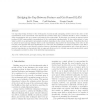TROB
2010
13 years 10 months ago
2010
—A novel approach toward construction of robots is based on a concentric combination of precurved elastic tubes. By rotation and extension of the tubes with respect to each other...
SOCROB
2010
13 years 10 months ago
2010
This research explores interactive games using hand and face tracking with a robot as a tool for autism therapy. The robot is equipped with a head and two arms, each with two degre...
SOCROB
2010
2010
Using the Interaction Rhythm as a Natural Reinforcement Signal for Social Robots: A Matter of Belief
13 years 10 months ago
Abstract. In this paper, we present the results of a pilot study of a human robot interaction experiment where the rhythm of the interaction is used as a reinforcement signal to le...
SMC
2010
IEEE
13 years 10 months ago
2010
IEEE
—This paper discusses and evaluates the role of shared control approach in a BCI-based telepresence framework. Driving a mobile device by using human brain signals might improve ...
SIMPAR
2010
13 years 10 months ago
2010
Abstract. The idea of component-based software engineering was proposed more that 40 years ago, yet only few robotics software frameworks follow these ideas. The main problem with ...
SAB
2010
Springer
13 years 10 months ago
2010
Springer
Playing table tennis is a difficult motor task which requires fast movements, accurate control and adaptation to task parameters. Although human beings see and move slower than mos...
RAS
2010
13 years 10 months ago
2010
This article investigates fundamental issues in scaling autonomous personal robots towards open-ended sets of everyday manipulation tasks which involve high complexity and vague j...
RAS
2010
13 years 10 months ago
2010
One important design decision for the development of autonomously navigating mobile robots is the choice of the representation of the environment. This includes the question which...
MICAI
2010
Springer
13 years 11 months ago
2010
Springer
The full deployment of service robots in daily activities will require the robot to adapt to the needs of non-expert users, particularly, to learn how to perform new tasks from “...
JIRS
2010
13 years 11 months ago
2010
Abstract Localization is a key issue for a mobile robot, in particular in environments where a globally accurate positioning system, such as GPS, is not available. In these environ...






